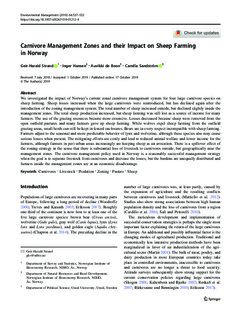| dc.contributor.author | Strand, Geir-Harald | |
| dc.contributor.author | Hansen, Inger | |
| dc.contributor.author | de Boon, Auvikki Ilmarar Bjerka | |
| dc.contributor.author | Sandström, Camilla | |
| dc.date.accessioned | 2020-01-13T11:24:31Z | |
| dc.date.available | 2020-01-13T11:24:31Z | |
| dc.date.created | 2019-11-09T13:17:31Z | |
| dc.date.issued | 2019-10-17 | |
| dc.identifier.citation | Environmental Management. 2019, 64 (5), 537-552. | nb_NO |
| dc.identifier.issn | 0364-152X | |
| dc.identifier.uri | http://hdl.handle.net/11250/2635941 | |
| dc.description.abstract | We investigated the impact of Norway’s current zonal carnivore management system for four large carnivore species on sheep farming. Sheep losses increased when the large carnivores were reintroduced, but has declined again after the introduction of the zoning management system. The total number of sheep increased outside, but declined slightly inside the management zones. The total sheep production increased, but sheep farming was still lost as a source of income for many farmers. The use of the grazing resources became more extensive. Losses decreased because sheep were removed from the open outfield pastures and many farmers gave up sheep farming. While wolves expel sheep farming from the outfield grazing areas, small herds can still be kept in fenced enclosures. Bears are in every respect incompatible with sheep farming. Farmers adjust to the seasonal and more predictable behavior of lynx and wolverine, although these species also may cause serious losses when present. The mitigating efforts are costly and lead to reduced animal welfare and lower income for the farmers, although farmers in peri-urban areas increasingly are keeping sheep as an avocation. There is a spillover effect of the zoning strategy in the sense that there is substantial loss of livestock to carnivores outside, but geographically near the management zones. The carnivore management policy used in Norway is a reasonably successful management strategy when the goal is to separate livestock from carnivores and decrease the losses, but the burdens are unequally distributed and farmers inside the management zones are at an economic disadvantage. | nb_NO |
| dc.language.iso | eng | nb_NO |
| dc.rights | Navngivelse 4.0 Internasjonal | * |
| dc.rights.uri | http://creativecommons.org/licenses/by/4.0/deed.no | * |
| dc.subject | Carnivores | nb_NO |
| dc.subject | Livestock | nb_NO |
| dc.subject | Predation | nb_NO |
| dc.subject | Zoning | nb_NO |
| dc.subject | Pasture | nb_NO |
| dc.subject | Sheep | nb_NO |
| dc.title | Carnivore Management Zones and their Impact on Sheep Farming in Norway | nb_NO |
| dc.type | Journal article | nb_NO |
| dc.type | Peer reviewed | nb_NO |
| dc.description.version | publishedVersion | nb_NO |
| dc.subject.nsi | VDP::Landbruks- og Fiskerifag: 900 | nb_NO |
| dc.source.pagenumber | 537-552 | nb_NO |
| dc.source.volume | 64 | nb_NO |
| dc.source.journal | Environmental Management | nb_NO |
| dc.source.issue | 5 | nb_NO |
| dc.identifier.doi | 10.1007/s00267-019-01212-4 | |
| dc.identifier.cristin | 1745633 | |
| dc.relation.project | Norges forskningsråd: 267982 | nb_NO |
| cristin.unitcode | 7677,5,0,0 | |
| cristin.unitcode | 7677,2,0,0 | |
| cristin.unitname | Divisjon for kart og statistikk | |
| cristin.unitname | Divisjon for skog og utmark | |
| cristin.ispublished | true | |
| cristin.fulltext | original | |
| cristin.qualitycode | 1 | |

